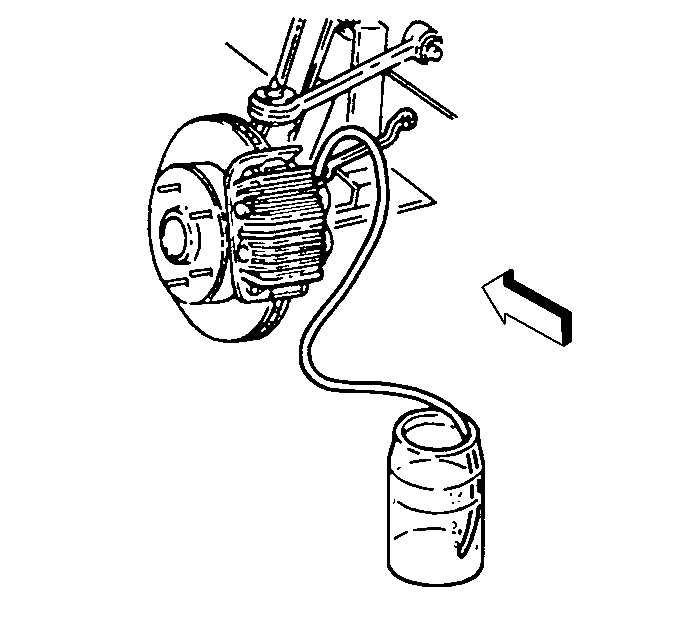Tool Required
J 21472 Brake Bleeder
Wrench
Manual Bleeding Procedure
Notice: When filling the master cylinder, use only Delco Supreme 11, GM P/N 12377967
(Canadian P/N 992667), or equivalent DOT 3 brake
fluid. Do not use a container which has been used for petroleum based fluids,
or a container which is wet with water. Petroleum based fluids will cause
swelling and distortion of rubber parts in the hydraulic brake system, and
water will mix with brake fluid, lowering the boiling point. Keep all fluid
containers capped to prevent contamination.
- Apply the brakes several times with the engine off to remove the
vacuum reserve.
- Use only brake fluid to fill the master cylinder reservoir. Ensure
to keep the master cylinder reservoir at least half full during the bleeding
operation.
- Perform the following steps if the master cylinder is known or
suspected to have air in the bore:
| 3.1. | Disconnect the front Electronic Brake Control Module (EBCM) pipe
fitting at the master cylinder. |
| 3.2. | Fill the master cylinder reservoir until fluid begins to flow
from the front (EBCM) pipe fitting port. |
| 3.3. | Connect the front (EBCM) pipe to the master cylinder. |
| 3.4. | Tighten the (EBCM) pipe to the master cylinder. |
| 3.5. | Have a helper depress the brake pedal slowly one time and hold. |
| 3.6. | Loosen the front (EBCM) pipe fitting at the master cylinder body
to purge the air from the bore. |
| 3.7. | Tighten the fitting. |
| 3.8. | Have the helper slowly release the brake pedal. |
Notice: Use the correct fastener in the correct location. Replacement fasteners
must be the correct part number for that application. Fasteners requiring
replacement or fasteners requiring the use of thread locking compound or sealant
are identified in the service procedure. Do not use paints, lubricants, or
corrosion inhibitors on fasteners or fastener joint surfaces unless specified.
These coatings affect fastener torque and joint clamping force and may damage
the fastener. Use the correct tightening sequence and specifications when
installing fasteners in order to avoid damage to parts and systems.
| 3.10. | Repeat above sequence, including
the 15 second wait, until all the air is removed from the brake master
cylinder. Ensure to prevent fluid from contacting any painted surface. |
Tighten
Tighten the brake master cylinder pipe fitting to 16 N·m
(12 lb ft).
| 3.11. | Repeat the procedure outlined above to bleed the air at the front
(EBCM) inlet pipe fitting. |
Tighten
Tighten the (EBCM) inlet pipe fitting to 16 N·m (12 lb ft).
| 3.12. | Repeat the procedure outlined above to bleed the rear (EBCM) fitting. |
Tighten
Tighten the rear (EBCM) pipe fitting to 16 N·m (12 lb ft).

- Bleed the front and/or
rear brake calipers only after all the air is removed from the brake master
cylinder and the (EBCM).
- Follow this sequence if bleeding all of the brake calipers is
necessary:
- Raise and suitably support the vehicle. Refer to
Lifting and Jacking the Vehicle
in General Information.
- Place a proper size box end wrench over the bleeder valve.
- Attach a clear tube over the front or the rear brake caliper bleeder
valve.
- Allow the tube to hang submerged in a clear container partially
filled with brake fluid.
- Have a helper depress the brake pedal slowly one time and hold.
- Loosen the bleeder valve to purge the air from the caliper.
- Tighten the caliper bleeder valve.
- Have the helper slowly release the brake pedal after the bleeder
valve is closed.
- Wait 15 seconds.
- Repeat the sequence, including the 15 second wait, until
all the air is removed.
Tighten
Tighten the brake caliper bleeder valve to 9 N·m (80 lb in).
- Note that rapid pumping of the brake pedal pushes the master cylinder
secondary piston down the master cylinder body bore. This will make bleeding
the rear side of the system more difficult.
- Lower the vehicle.
- Fill the reservoir with brake fluid. Refer to
Fluid and Lubricant Recommendations
in Maintenance and Lubrication.
- Inspect for the following conditions:
| • | Inspect the brake pedal for sponginess. |
| • | Inspect the red BRAKE warning indicator lamp for proper operation. |
- Repeat the entire bleeding procedure if the brake pedal feels
spongy or the red Brake warning indicator fails to turn off.

